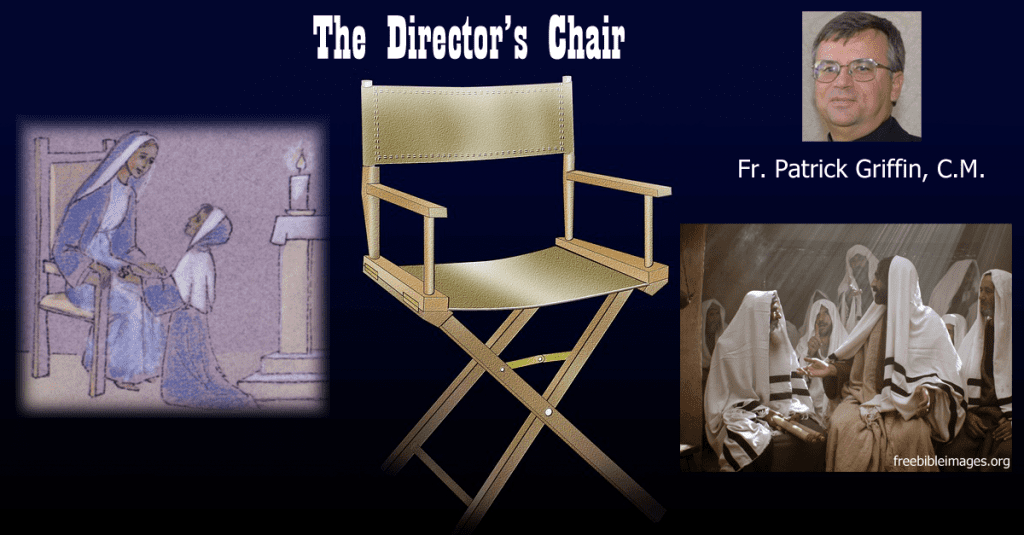
Pat Griffin CM continues his series on Consecrated Life with this reflection on the Director’s Chair.
Recently, I took on a new role at St. John’s University. I have assumed the primary responsibility for the Vincentian Center for Church and Society (VCCS). With that role comes a position both literally and figuratively. Now, I find myself sitting in the Executive Director’s chair and it still feels like someone might come in and catch me. I know what a “pretender to the throne” should feel like.
This most recent experience put me in mind of another chair in another place. For some time in the 19th Century, in the Chapel on the rue du Bac, the “Director’s Chair” meant that chair which was placed in the sanctuary and was used by the Director General of the Daughters of Charity when he gave his conferences. When Catherine Labouré encounters the Blessed Mother, Mary is seated in this chair! What strikes me is that the Directors of the Daughters continued to sit in that chair for decades afterwards because Catherine’s experience had not been made known. One never knows whose place one takes. Now, of course, this chair has a privileged and protected spot in the Chapel. A few times, I needed to give a conference to our Sisters while seated. The playful part of me wondered if I should ask to use my “Director’s Chair.” Some would note that again I was planted in a place where I did not belong. Not every chair is meant to be filled by anyone.
Sometimes, however, we need to take the seat. Young couples need to take the chairs of parents; students need to move behind the desk to the perch of teachers; congregants need to move to the center of liturgical celebrations as ministers. We understand why the one elected Pope takes the Chair of Peter, and the leader of an organization becomes “the Chair.” “Growing up” demands that one take a place of responsibility. It is part of the maturing process. One cannot and should not avoid its summons or implications.
Where one sits often determines one’s role and one’s status. Remember how Jesus sits down to deliver the Sermon on the Mount (Mt 1:1) and to teach after reading the scroll in the Synagogue of Nazareth:
Rolling up the scroll, he handed it back to the attendant and sat down, and the eyes of all in the synagogue looked intently at him. (Lk 4:20)
In these contexts, the sitting indicated the role of the rabbi; all were called to listen to the words which would now issue from his mouth. From the other side, we can envision how Mary places herself at the feet of the seated Jesus receiving the “better part” while Martha prepared the hospitality.
Jesus speaks of the importance of choosing where one reclines at table:
[Jesus] told a parable to those who had been invited, noticing how they were choosing the places of honor at the table. “When you are invited by someone to a wedding banquet, do not recline at table in the place of honor. A more distinguished guest than you may have been invited by him, and the host who invited both of you may approach you and say, ‘Give your place to this man,’ and then you would proceed with embarrassment to take the lowest place. Rather, when you are invited, go and take the lowest place so that when the host comes to you he may say, ‘My friend, move up to a higher position.’ Then you will enjoy the esteem of your companions at the table.” (Lk 14:7-10)
We understand what this means: a person should position him/herself at a place appropriate to one’s role and responsibilities. A Vincentians willingness to take the lowest place coincides with our charism to serve those who are most abjectly poor.
The Chair can remind us of the roles of authority and obedience in the consecrated life. One of the healthy dynamics in this vocation consists in the fact that the chair does not belong to one for life. After a time, one must surrender it and allow another to take up the mantle. That is an appropriate process. We assume the role of serving the community in leadership with an attitude of honesty, humility, resolve and perspective. Our hope is to build on the work of the one who has preceded us, and to prepare the way for the one who will succeed us— consistently with the needs of the community in mind. Occupying the chair remains temporary and always transferable. Sometimes we sit on it and sometimes we sit at it. The secret is neither to flee from it nor to seek it too readily.
During the course of our lives, we will sit at and around many chairs. In the Vincentian Family, at times we need to assume the place of Vincent or Louise or Frederic or Elizabeth Ann in the service of our masters, the poor. Vincent writes about this and its characteristic attitude:
“Christian leadership implies and requires humility. I did not come to be served, but to serve . . .” (VdP, CCD 13a:105, p. 392)
At other times, we need to find our place at the feet of those who can teach us best about love and care and the meaning of vows. A challenge is to know when and where we need to seat ourselves. At a Vincentian gathering, however, the lowest places should never be empty.







0 Comments